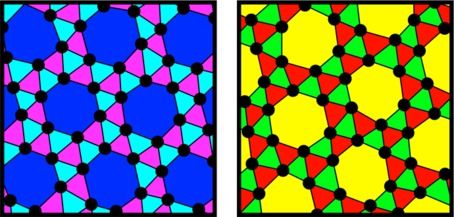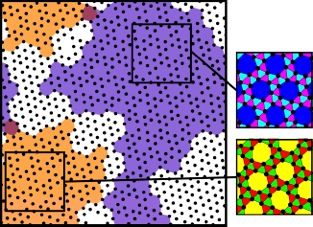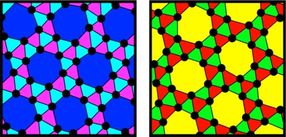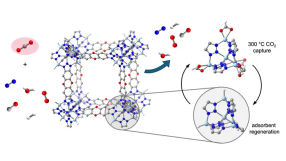Chiral asymmetry can emerge from maximal symmetry
Researchers at Chalmers have shown that maximally symmetric systems of particles can spontaneously produce two different patterns, which are mirror images of each other. The results have been published in Physical Review Letters. The research group is working towards a mathematical design of self-assembling nanomaterials.

These two patterns are mirror images of each other. To see the difference between them, compare how a row with six triangles connects to one of the hexagonal shapes. A chiral pattern of this kind can occur despite the fact that all particles (dots) are the same type and acting with equal force in all directions.
Physical Review Letters: “Chiral Surfaces Self-Assembling in One-Component Systems with Isotropic Interactions”.

In computer simulations, the areas with the two different mirror variations compete with each other when the particles arrange themselves in the structure. Finally, one chiral variation takes over the entire system. Which one is a matter of chance.
Physical Review Letters: “Chiral Surfaces Self-Assembling in One-Component Systems with Isotropic Interactions”.


The Chalmers researchers are working on so-called self-assembling systems. The aim is to calculate how to construct molecular building blocks which, when mixed together, self-assemble into advanced nanomaterials – like pieces of a puzzle that completes itself.
An important property in many chemical and physical systems is something called chirality. Most larger molecules are chiral, which means they exist in two different versions that are mirror images of each other, like our left and right hands. The two versions often produce a completely different effect in, for example, the human body. One well known example of this is the drug thalidomide, where one chiral variation of the active molecule can cause birth defects.
Chirality normally occurs when different types of particle or atoms combine into complex molecules. Researchers at Chalmers have now, however, demonstrated something completely new in the field of physics: chirality can occur spontaneously, even in systems that comprise only a single type of basic, spherically symmetric particle. This means that it doesn’t matter how the particles are rotated in relation to one another. The forces acting between the particles depend only on the distance between them.
“Chiral asymmetry can therefore occur spontaneously in a system where the basic condition is maximal symmetry”, says Martin Nilsson Jacobi, head of the research group. “This is an important breakthrough in our attempt to develop self-assembling materials. It may also shed new light on the issue of why chirality is so prevalent in nature.”
The basis for the discovery is a mathematical method developed by the research group. This method enables them to take any crystal and calculate exactly which forces are required between the particles to form this exact crystal. This is a new technique for designing self-assembling systems, and has also been published in Physical Review Letters.
The majority of researchers in the field use experiments and data simulations to cope with the enormous complexity represented by self-assembling systems. To design the building blocks that lead to a desired structure, the components are gradually altered to try and achieve the correct final result. Chalmers researchers, however, calculate the solution to the design problem in advance.
“We design the building blocks mathematically”, says Martin Nilsson Jacobi. “So far, the forces between the particles produced using our methods are too complicated to be implemented in the lab, but we are working to simplify them in various ways.”
The group is currently developing analytical methods to construct nanoparticles whose surfaces are covered by molecules in a set pattern. The molecules will enable the particles to combine in exactly the right way to form desired structures.
“Research into material manufacturing is currently focusing increasingly on self-assembling materials”, says Martin Nilsson Jacobi. “One source of inspiration is living cells, where self-assembly and self-reparation take place all the time. Incredibly complex molecular machineries are assembled spontaneously, when atoms and molecules attach themselves to one another with different types of bindings.”
Researchers across the world are now attempting to emulate these systems, which evolution has created and fine-tuned over millions of years. They can also create wholly new materials with exotic properties which do not occur in nature, so-called metamaterials. Examples are materials that do not propagate sound in certain frequency bands, or materials that do not expand when heated.
































































